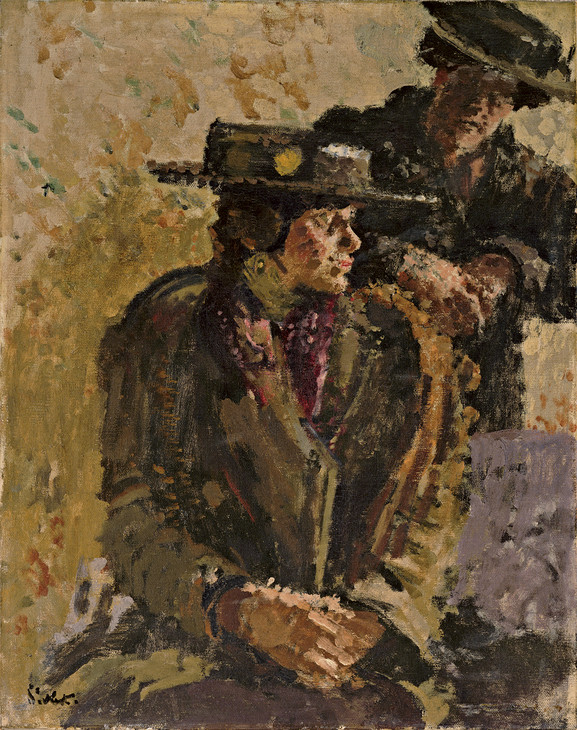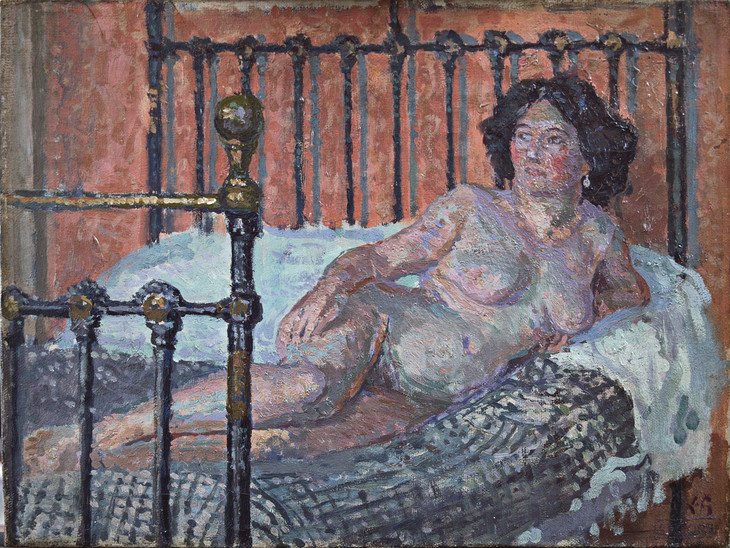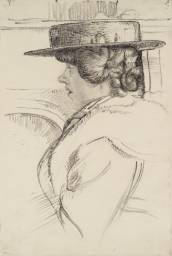Spencer Gore North London Girl c.1911-12
Spencer Gore,
North London Girl
c.1911-12
The sitter of Gore’s picture helped serve tea at the Saturday afternoon ‘At Homes’ held at 19 Fitzroy Street, where artists and collectors gathered to display and discuss painting. The woman lived in nearby Cumberland Market, and is shown here in hat and overcoat as if she has just arrived or is about to depart the cosy surroundings. Gore pays as much attention to the luminosity of her complexion – drawn out with greens, blues and pinks – as to the billowing folds of the curtain and the floral wallpaper behind her.
Spencer Gore 1878–1914
North London Girl
c.1911–12
Oil paint on canvas
760 x 610 mm
Inscribed by Harold Gilman ‘painted by SPF Gore in 1909, signed (74)’ in ink and ‘1908/09’ in pencil on paper label on back; studio stamp ‘S.F. GORE’ bottom right.
Bequeathed by J.W. Freshfield 1955
T00027
c.1911–12
Oil paint on canvas
760 x 610 mm
Inscribed by Harold Gilman ‘painted by SPF Gore in 1909, signed (74)’ in ink and ‘1908/09’ in pencil on paper label on back; studio stamp ‘S.F. GORE’ bottom right.
Bequeathed by J.W. Freshfield 1955
T00027
Ownership history
Mrs Mary Johanna Gore, the artist’s widow; bought at the French Gallery, London, in autumn 1928 for £190 by J.W. Freshfield who bequeathed it to Tate Gallery 1955.
Exhibition history
1928
An Exhibition of Modern Art, French Gallery, London, Autumn 1928 (53, as ‘A Portrait’).
1935
Fifty Years of Portraits, Leicester Galleries, London, May–June 1935 (106, as ‘Portrait of a Young Woman’).
1936
Twee Eeuwen Engelsche Kunst, Stedelijk Museum, Amsterdam, July–October 1936 (57).
1938
La Peinture Anglaise XVIIIe & XIXe Siècles, British Council, Palais du Louvre, Paris 1938 (61, as ‘Portrait de Femme’, reproduced).
1951
The Camden Town Group, Southampton City Art Gallery, June–July 1951 (58, reproduced).
1951
Ten Decades: A Review of British Taste 1851–1951, Institute of Contemporary Art and Arts Council, Royal Society of British Artists Galleries, London, October 1951 (171).
1968
In and Around the Slade, Laing Art Gallery, Newcastle upon Tyne, February–March 1968 (4).
1970
Spencer Gore 1878–1914, The Minories, Colchester, March–April 1970, Ashmolean Museum, Oxford, April 1970, Graves Art Gallery, Sheffield, May–June 1970 (39).
1972–6
Southampton City Art Gallery, June 1972–August 1976, (long loan).
1976
Camden Town Recalled, Fine Art Society, London, October–November 1976, Graves Art Gallery, Sheffield, November–December 1976 (66).
2008
Modern Painters: The Camden Town Group, Tate Britain, London, February–May 2008 (43, reproduced).
References
1938
Michel Florisoone, ‘Les Peintures et leurs oeuvres au XVIIIe et au XIXe Siècle’, L’Amour de l’art, vol.19, no.2, 1938, p.84, reproduced.
1956
Tate Gallery Report 1955–56, London 1956, p.17.
1962
John Rothenstein, British Art since 1900, London 1962, reproduced pl.14.
1964
Mary Chamot, Dennis Farr and Martin Butlin, Tate Gallery Catalogues: The Modern British Paintings, Drawings and Sculpture, vol.1, London 1964, pp.248–9.
1952
John Rothenstein, Modern English Painters: Sickert to Smith, London 1952, p.197, reproduced pl.25.
1979
Wendy Baron, The Camden Town Group, London 1979, pp.20, 166, 168, 374, reproduced pl.42.
2000
Wendy Baron, Perfect Moderns: A History of the Camden Town Group, Aldershot and Vermont 2000, pp.33, 181.
Technique and condition
North London Girl is painted in artists’ oil paints on prepared stretched canvas. A paper label inscribed in Harold Gilman’s hand is attached to the back of the stretcher, and reads: ‘painted by SPF Gore in 1909, signed (74)’; beneath the ink is an earlier date in pencil of 1908/09 (see also Tate T02260). The canvas is plain, coarse-weave linen. It is prepared with a distinct layer of glue size and dense pure lead-white priming, probably in an oil medium. The mark of the artists’ colourman Percy Young is stamped on the back of the cloth. The canvas is stretched over a four-member stretcher and attached with steel tacks which remain in their original positions. The dimensions of the painting conform to a standard commercial size, historically called ‘head size’, suggesting that the support was probably purchased pre-stretched from the colourman.
There is no visible sign of underdrawing or squaring up. The composition was initially drawn in blue paint, which can be seen where the paint film is thinner, for example the sitter’s head and left shoulder (see also Tate T02260). The subject is reduced to areas of decorative colour and pattern of equal emphasis, while Gore has subtly retained the character of each form by varying the brushwork. The curtain, furnishings and sitter’s clothing are boldly handled with loose strokes of rich paint worked wet-in-wet to create a lively surface with low impasto. The wallpaper is blended wet-in-wet using a more fluid paint and imparting a sense of flatness. The lower left of the composition is summarily described with rapid sketchy brushwork leaving priming exposed. The sitter’s hat and face are closely worked: greens, blues, pinks and yellows are applied with short directional strokes juxtaposing complementary colours finding hue in light and shadow to evoke the luminosity of her complexion. Gore synthesised the treatment of colour and line that he observed in the work of French impressionist painting earlier than Gilman. By 1908–9 he had already begun to question traditional ways of using colour, moving away from the reliance on earth colours to measure tonality, as he wrote to his student John Doman Turner:
When paintings were based on burnt sienna, if the burnt sienna was not balanced by a sufficient quantity of green or blue or green grey or blue grey you were at liberty to say at once this painting is too hot, or passage [sic] in a painting. If on the other hand the burnt sienna was too much obscured by the green or the grey or the blue even a child could say this painting is too cold.
The studio stamp at the lower right-hand corner in a mauve coloured oil paint is composed of a mixture of lead white, alizarin crimson, synthetic ultramarine, possibly some bone black and kaolin extender to make the colour. The stamp is consistent with others found on Gore’s work and was probably applied by Gilman at the same time that he wrote and attached the label to the back. The painting appears to have been varnished using a cloth after the studio stamp was applied.
Roy Perry and Sarah Morgan
May 2004
Notes
How to cite
Roy Perry and Sarah Morgan, 'Technique and Condition', May 2004, in Robert Upstone, ‘North London Girl c.1911–12 by Spencer Gore’, catalogue entry, May 2009, in Helena Bonett, Ysanne Holt, Jennifer Mundy (eds.), The Camden Town Group in Context, Tate Research Publication, May 2012, https://wwwEntry
Sitter
The name of the sitter is not known, but in a letter to the Tate Gallery of October 1960, Gore’s widow Mollie recalled that ‘she was such a nice woman, married, with several children. She kept the rooms clean at 19 Fitzroy Street dispensed tea on Saturday afternoons, looking v. handsome in a black velvet dress.’1 The writer John Woodeson stated that:
Mrs S. Gore informed me that the picture was painted in Mornington Crescent in the second floor front sitting room.2 The woman was employed to clean the studio at 19 Fitzroy Street and later the Gore’s home at Houghton Place, and occasionally babysat for Mrs. Gore. She was married with six children, and lived not far away in Cumberland Market.3
Gore’s Woman Standing in a Window c.1908 (Beaverbrook Art Gallery, Fredericton, Canada) appears to be another portrait of the same person. The sitter in his Nude 1910 (fig.1), which once belonged to Gilman, seems to have an even closer similarity to the sitter in North London Girl.
19 Fitzroy Street
It had been Sickert’s idea in spring 1907 to rent first-floor rooms at 19 Fitzroy Street where works by a loose association of artists with whom he felt in sympathy might be displayed and sold. The founder members were Sickert, Gore, Gilman, Walter Russell, William Rothenstein and Albert Rutherston, who were joined shortly afterwards by Lucien Pissarro, Ethel Sands and Nan Hudson, and in 1908 by Robert Bevan. It was from this nucleus that later the Camden Town Group would partly be drawn. The Fitzroy Street painters held regular gatherings on Saturday afternoons, where works on show would be discussed and potential patrons invited to purchase. It was partly an attempt to break free from a reliance on dealers, who were not always sympathetic to their work, and therefore gain a degree of independence. Sickert explained in a letter to Hudson that in setting up the Fitzroy Street salon it was his intention to:
Accustom people weekly to see work in a different notation from the current English one. Make it clear that we all have work for sale at prices that people of moderate means could afford. (That a picture costs less than a supper at the Savoy.) Make known the work of painters who are already producing ripe work, but who are still elbowed or kept out by timidity etc ... And of course no one will feel we are jumping at the throats to buy. That comes of its own accord. People pay attention to things seen constantly and judiciously explained a little.4
But Sickert also explained that he set up this exhibiting circle ‘for 2 reasons’:
Because it is more interesting to people to see the work of 7 or 9 people than one and because I want to keep up an incessant proselytizing agency to accustom people to mine and other painters’ work of a modern character. Every week we could put something different on the easels ... All the painters interested could keep work there and would have keys and could show anything by appointment to anyone at any time ... I want to create a Salon d’automne milieu in London.5
The art collector Sir Louis Fergusson gave a vivid recollection in 1930 of the ‘At Homes’ at 19 Fitzroy Street:
There was an appetising smell of tea and pigment as you ascended to a glorious afternoon of pictures and of talk. Easels and chairs faced the fireplace with a serried stack of canvases against the wall. Six works or more of an individual painter were extricated in turn, each Fitzroyalist displaying his quota or having it displayed for him by the untiring Gore ... Mr. Sickert put every caller at his ease. ‘It is so nice,’ he said, for example, to an appreciative but diffident visitor ‘to come across a person with the same religion as oneself – a good Impressionist!’ Sickert was the host-in-chief ... Next might come the turn of Gore himself. He had the look of a dreamer, and the whimsical charm of his manner seemed to suggest that his art was making him supremely happy.6
Patrons who attended the Fitzroy Street afternoons included Sir Hugh Lane, Cyril Butler, Hugh Hammersley, Judge William Evans, Walter Taylor, Mrs Charles Hunter, Mrs Donaldson Hudson and Mrs Salaman, well-off individuals who were established collectors. Discussing the types of people he wished to attract, in 1907 Sickert had written to Hudson:
I want (and this we can all understand and never say) to get together a milieu rich or poor, refined or even to some extent vulgar, which is interested in painting and in the things of the intelligence, and which has not ... an aggressively anti-moral attitude. To put it on the lowest grounds, it interferes with business.7
Women in interiors

Walter Richard Sickert 1860–1942
The New Home 1908
Oil paint on canvas
495 x 390 mm
Private collection, Ivor Braka Ltd
© Estate of Walter R. Sickert / DACS
Photo © Ivor Braka Ltd, London
Fig.2
Walter Richard Sickert
The New Home 1908
Private collection, Ivor Braka Ltd
© Estate of Walter R. Sickert / DACS
Photo © Ivor Braka Ltd, London

Walter Richard Sickert 1860–1942
Two Women c.1911
Oil paint on canvas
508 x 406 mm
Harris Museum and Art Gallery, Preston
© Estate of Walter R. Sickert / DACS
Photo © Harris Museum and Art Gallery, Preston
Fig.3
Walter Richard Sickert
Two Women c.1911
Harris Museum and Art Gallery, Preston
© Estate of Walter R. Sickert / DACS
Photo © Harris Museum and Art Gallery, Preston

Spencer Gore 1878–1914
The Flowered Hat or Someone Who Waits c.1907
Oil on canvas
508 x 406 mm
Plymouth City Museum and Art Gallery
Photo © Plymouth City Museum and Art Gallery
Fig.4
Spencer Gore
The Flowered Hat or Someone Who Waits c.1907
Plymouth City Museum and Art Gallery
Photo © Plymouth City Museum and Art Gallery
In North London Girl, Gore treats the sitter with sensitivity and seeks to evoke something of her character. Gore believed strongly in the role of the artist as observer, and felt it wrong to impose too much personality on a portrait. He wrote to his pupil John Doman Turner:
That the artist comments on life as he sees it by means of some material, and he may digest his observations in any way, that is he may be a decorative painter or a sculptor or a naturalistic painter. He may have much or little to say. But they must be first hand observation of life and nature: he cant feed either on his own entrails or anyone elses. Taste is only a fashion or an attempt to form a fashion. The artist must be outside it, a looker on, a recorder of it, but not an apostle or a propogandist. If painting a portrait for instance, its not the business of the painter to dress his sitter to show his taste in dress, but to have them in the clothes naturally characteristic of them.12

Harold Gilman 1876–1919
Stanislawa de Karlowska (Mrs Robert Bevan) c.1913
Oil on canvas
618 x 514 mm
Yale Center for British Art, Paul Mellon Fund
Fig.5
Harold Gilman
Stanislawa de Karlowska (Mrs Robert Bevan) c.1913
Yale Center for British Art, Paul Mellon Fund
When Sickert showed The New Home at the New English Art Club in the summer of 1908, the critic for the Pall Mall Gazette commented that, ‘Here is a woman ill at ease, apparently her hat not yet removed’.15 It was socially acceptable for Edwardian women to keep their hats on indoors, and might have been normal at more formal social gatherings. But at home it would have been unusual. Consequently, the fact that the models are wearing hats lends a certain tension to the scene, as if they have just come inside, or are about to leave. The sitter in North London Girl also seems to be wearing her outdoor coat, which accentuates the feeling of discomfort and lack of relaxation, in opposition to the domestic setting in which she is seated. The lack of an object on which her gaze might be focused suggests that she is staring into space, lost in thought, looking inwards rather than outwards. Similarly, it allows the spectator to scrutinise her without the gaze being met or challenged, a great contrast to the direct, confident stare of Mollie Gore in The Artist’s Wife 1913 (Tate T03561), and one which perhaps reflects the artist’s conscious or unconscious attitude towards the sitter’s status as a servant.
Ownership and date
The first owner of the painting was J.W. Freshfield who purchased a number of Camden Town pictures between the two world wars. In addition to North London Girl he also bequeathed to the Tate Gallery Gore’s The Fig Tree 1912 (Tate T00028), and to the Fitzwilliam Museum, Cambridge, Gore’s Morning: The Green Dress c.1908–9,16 122 prints by Sickert, and Sickert’s Lady in Red: Mrs Swinton c.1906.17
Although Harold Gilman dated the work 1908–9 on a label on the back of the canvas after Gore’s death in 1914, the style of the work makes it more likely c.1911–12.
Robert Upstone
May 2009
Notes
Walter Sickert, letter to Nan Hudson, 1907, Tate Archive TGA 9125/5; quoted in Wendy Baron, Perfect Moderns: A History of the Camden Town Group, Aldershot and Vermont 2000, p.26.
Louis Fergusson, ‘Souvenir of Camden Town: A Commemorative Exhibition’, Studio, vol.90, February 1930, pp.111–12.
Reproduced in Sickert: Paintings, exhibition catalogue, Royal Academy, London 1992 (52), and Wendy Baron, Sickert: Paintings and Drawings, New Haven and London 2006, no.267.
Walter Sickert, letter to Ethel Sands and Nan Hudson, Tate Archive TGA 9125/5; quoted in Royal Academy 1992 (67).
Related biographies
Related essays
- City Visions: The Urban Scene in Camden Town Group and Ashcan School Painting David Peters Corbett
- Questions of Artistic Identity, Self-Fashioning and Social Referencing in the Work of the Camden Town Group Andrew Stephenson
- London’s Fashion Culture and the Camden Town Group Painters Christopher Breward
- A History of Camden Town 1895–1914 David Hayes
- From Drawing Room to Scullery: Reading the Domestic Interior in the Paintings of Walter Sickert and the Camden Town Group Juliet Kinchin
Related catalogue entries
Related archive items
Related reviews and articles
- Louis F. Fergusson, ‘Souvenir of Camden Town: A Commemorative Exhibition’ The Studio, February 1930, pp.111–9.
How to cite
Robert Upstone, ‘North London Girl c.1911–12 by Spencer Gore’, catalogue entry, May 2009, in Helena Bonett, Ysanne Holt, Jennifer Mundy (eds.), The Camden Town Group in Context, Tate Research Publication, May 2012, https://www





